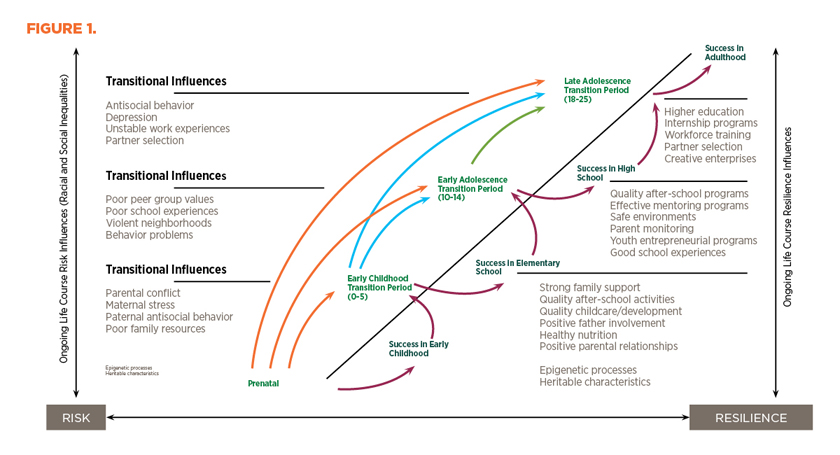Children and Adversity
- Hiram E. Fitzgerald
- University Distinguished Professor, Department of Psychology
- Associate Provost for University Outreach and Engagement
- Michigan State University
 The expanding social, economic, and racial inequities in American society are linked to increases in negative outcomes for children via exposure to adverse childhood experiences (ACEs) or toxic stress.
The expanding social, economic, and racial inequities in American society are linked to increases in negative outcomes for children via exposure to adverse childhood experiences (ACEs) or toxic stress.
Data compiled by Child Trends (Table 1) suggest that the number of children exposed to multiple forms of ACE increases over time. The net result is that during the time of the most rapid and comprehensive changes in neurobiological development, organization of human stress regulatory systems, interpersonal dynamics, and the emergence of embodied mental representations of self, children are experiencing multiple forms of risk.
Childhood sexual abuse is not directly listed in Table 1, but estimates now suggest that 1 in 3 girls and 1 in 5 boys experience some form of sexual abuse during childhood, and by age 18, 40% of females and 30% of males have experienced sexual molestation.
Because ACEs contribute so significantly to the development and maintenance of health risks, pediatricians Jack Shonkoff and Andrew Garner (2012) now assert that the basic science of contemporary pediatrics is anchored in epigenetics, neuroscience, and life-course science, including the social and behavioral sciences that address social and environmental sources of adversity.

*Adapted from Table 3 of Sacks, V. H., Murphey, D., & Moore, K. (2014). Adverse childhood experiences: National and state-level prevalence. Washington, DC: Child Trends.
Cascading Developmental Pathways
As sources of risk accumulate, they begin to coalesce or cascade into developmental pathways that push the individual toward the risk side of the risk-resilience continuum (see Figure 1). While all children are affected by ACEs, increasing evidence suggests that ACEs have different effects on brain development in boys and girls.

*Figure 1. Risk-Resilience Continuum. Adapted from Fitzgerald, H. E., & Simon, L. A. K. (2012). The world grant ideal and engagement scholarship. Journal of Higher Education Outreach and Engagement, 16, 35-55.
One such region of the brain, referred to as the insula, is involved in regulating emotions and empathy. Other evidence points to differences in the organization of the right hemisphere and its mediation of toxic stress and relationship dynamics (Schore, 2017), with boys particularly negatively affected by toxic stress.
Recently Paul Golding and I (2017) drew together a team of researchers to examine the extent to which ACEs contribute to risk pathways for boys, with a special focus on factors that contribute to instability in conduct and relationship disorders, antisocial behavior, and violence. We currently are assembling another international set of scientists to examine the early origins of violence in males, spanning the life course from prenatal development through adolescence.
While developmental scientists may have disagreements about developmental processes contributing to the organization of psychopathology, few contest the hypothesis that the origins are rooted in the prenatal-to-five age period. Moreover, because development is now firmly viewed as dynamic and synergistically reflective of the organization of the individual in her/his environmental context, a deeper understanding of the need for more specialized prevention and intervention programs is emerging.
This understanding is reflected in five consensus understandings about prolonged or increasingly cascaded exposure to ACEs (National Symposium on Early Childhood Science and Policy; developingchild.harvard.edu).
- Early experiences influence the developing brain;
- Chronic stress can be toxic to the developing brain;
- ACEs have negative effects on life-course health and well-being;
- Early interventions can mute or eliminate long-term effects of ACEs; and
- Exposure to caring relationships from infancy through adolescence provides resilience against factors detrimental to healthy development.
Strategies for Evaluating Complex Models of Development
Investigators at Michigan State University spanning every college and nearly every discipline are actively involved in studying and evaluating complex models of human development, driven increasingly by transdisciplinary teams. Transdisciplinary teams attempt to understand the emergence and organization of complex systems that link brain development, neurobiological regulatory systems, gene-environment transactions, human relationship development, embodiment of sensory and perceptual processes, and the emergent sense of self in relation to experience that can guide children onto positive cascading pathways resulting in healthy well-being.
This issue of The Engaged Scholar Magazine captures some of this work, providing exemplars of the research and scholarly efforts of MSU faculty and academic staff to enhance the quality of life for the citizens of Michigan and beyond. Understanding the origins of ACEs and developing aggressive programs and policies to enhance children's exposure to positive life course experiences can significantly reduce costs to society related to remediation of the life-course outcomes related to childhood trauma.
References
- Fitzgerald, H. E., & Simon, L. A. K. (2012). The world grant ideal and engagement scholarship. Journal of Higher Education Outreach and Engagement, 16(3), 33-55.
- Golding, P., & Fitzgerald, H. E. (2017). Psychology of boys at risk: Indicators from 0-5. Infant Mental Health Journal, 38, 5-14.
- Schore, A. (2017). All our sons: The developmental neurobiology and neuroendocrinology of boys at risk. Infant Mental Health Journal, 38, 15-52.
- Shonkoff, J. P., & Garner, A. S. (2012). The lifelong effects of early childhood adversity and toxic stress. Pediatrics. doi:10.15542/peds.2011-2663.
- Written by Hiram E. Fitzgerald, University Outreach and Engagement